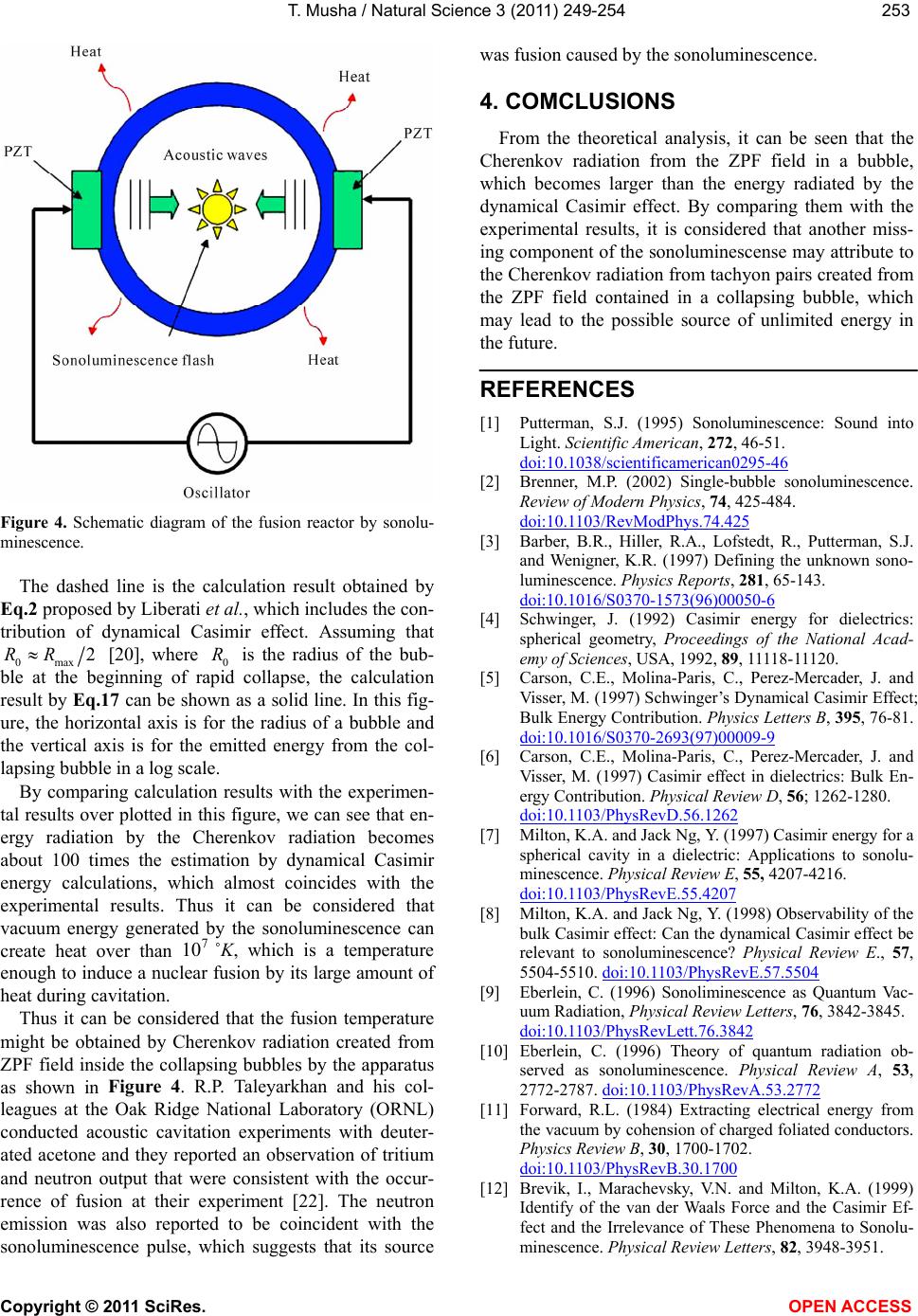
T. Musha / Natural Science 3 (2011) 249-254
Copyright © 2011 SciRes. OPEN ACCESS
253253
Figure 4. Schematic diagram of the fusion reactor by sonolu-
minescence.
The dashed line is the calculation result obtained by
Eq.2 proposed by Liberati et al., which includes the con-
tribution of dynamical Casimir effect. Assuming that
0max
2RR [20], where 0
R is the radius of the bub-
ble at the beginning of rapid collapse, the calculation
result by Eq.17 can be shown as a solid line. In this fig-
ure, the horizontal axis is for the radius of a bubble and
the vertical axis is for the emitted energy from the col-
lapsing bubble in a log scale.
By comparing calculation results with the experimen-
tal results over plotted in this figure, we can see that en-
ergy radiation by the Cherenkov radiation becomes
about 100 times the estimation by dynamical Casimir
energy calculations, which almost coincides with the
experimental results. Thus it can be considered that
vacuum energy generated by the sonoluminescence can
create heat over than 107 ˚K, which is a temperature
enough to induce a nuclear fusion by its large amount of
heat during cavitation.
Thus it can be considered that the fusion temperature
might be obtained by Cherenkov radiation created from
ZPF field inside the collapsing bubbles by the apparatus
as shown in Figure 4. R.P. Taleyarkhan and his col-
leagues at the Oak Ridge National Laboratory (ORNL)
conducted acoustic cavitation experiments with deuter-
ated acetone and they reported an observation of tritium
and neutron output that were consistent with the occur-
rence of fusion at their experiment [22]. The neutron
emission was also reported to be coincident with the
sonoluminescence pulse, which suggests that its source
was fusion caused by the sonoluminescence.
4. COMCLUSIONS
From the theoretical analysis, it can be seen that the
Cherenkov radiation from the ZPF field in a bubble,
which becomes larger than the energy radiated by the
dynamical Casimir effect. By comparing them with the
experimental results, it is considered that another miss-
ing component of the sonoluminescense may attribute to
the Cherenkov radiation from tachyon pairs created from
the ZPF field contained in a collapsing bubble, which
may lead to the possible source of unlimited energy in
the future.
REFERENCES
[1] Putterman, S.J. (1995) Sonoluminescence: Sound into
Light. Scientific American, 272, 46-51.
doi:10.1038/scientificamerican0295-46
[2] Brenner, M.P. (2002) Single-bubble sonoluminescence.
Review of Modern Physics, 74, 425-484.
doi:10.1103/RevModPhys.74.425
[3] Barber, B.R., Hiller, R.A., Lofstedt, R., Putterman, S.J.
and Wenigner, K.R. (1997) Defining the unknown sono-
luminescence. Physics Reports, 281, 65-143.
doi:10.1016/S0370-1573(96)00050-6
[4] Schwinger, J. (1992) Casimir energy for dielectrics:
spherical geometry, Proceedings of the National Acad-
emy of Sciences, USA, 1992, 89, 11118-11120.
[5] Carson, C.E., Molina-Paris, C., Perez-Mercader, J. and
Visser, M. (1997) Schwinger’s Dynamical Casimir Effect;
Bulk Energy Contribution. Physics Letters B, 395, 76-81.
doi:10.1016/S0370-2693(97)00009-9
[6] Carson, C.E., Molina-Paris, C., Perez-Mercader, J. and
Visser, M. (1997) Casimir effect in dielectrics: Bulk En-
ergy Contribution. Physical Review D, 56; 1262-1280.
doi:10.1103/PhysRevD.56.1262
[7] Milton, K.A. and Jack Ng, Y. (1997) Casimir energy for a
spherical cavity in a dielectric: Applications to sonolu-
minescence. Physical Review E, 55, 4207-4216.
doi:10.1103/PhysRevE.55.4207
[8] Milton, K.A. and Jack Ng, Y. (1998) Observability of the
bulk Casimir effect: Can the dynamical Casimir effect be
relevant to sonoluminescence? Physical Review E., 57,
5504-5510. doi:10.1103/PhysRevE.57.5504
[9] Eberlein, C. (1996) Sonoliminescence as Quantum Vac-
uum Radiation, Physical Review Letters, 76, 3842-3845.
doi:10.1103/PhysRevLett.76.3842
[10] Eberlein, C. (1996) Theory of quantum radiation ob-
served as sonoluminescence. Physical Review A, 53,
2772-2787. doi:10.1103/PhysRevA.53.2772
[11] Forward, R.L. (1984) Extracting electrical energy from
the vacuum by cohension of charged foliated conductors.
Physics Review B, 30, 1700-1702.
doi:10.1103/PhysRevB.30.1700
[12] Brevik, I., Marachevsky, V.N. and Milton, K.A. (1999)
Identify of the van der Waals Force and the Casimir Ef-
fect and the Irrelevance of These Phenomena to Sonolu-
minescence. Physical Review Letters, 82, 3948-3951.